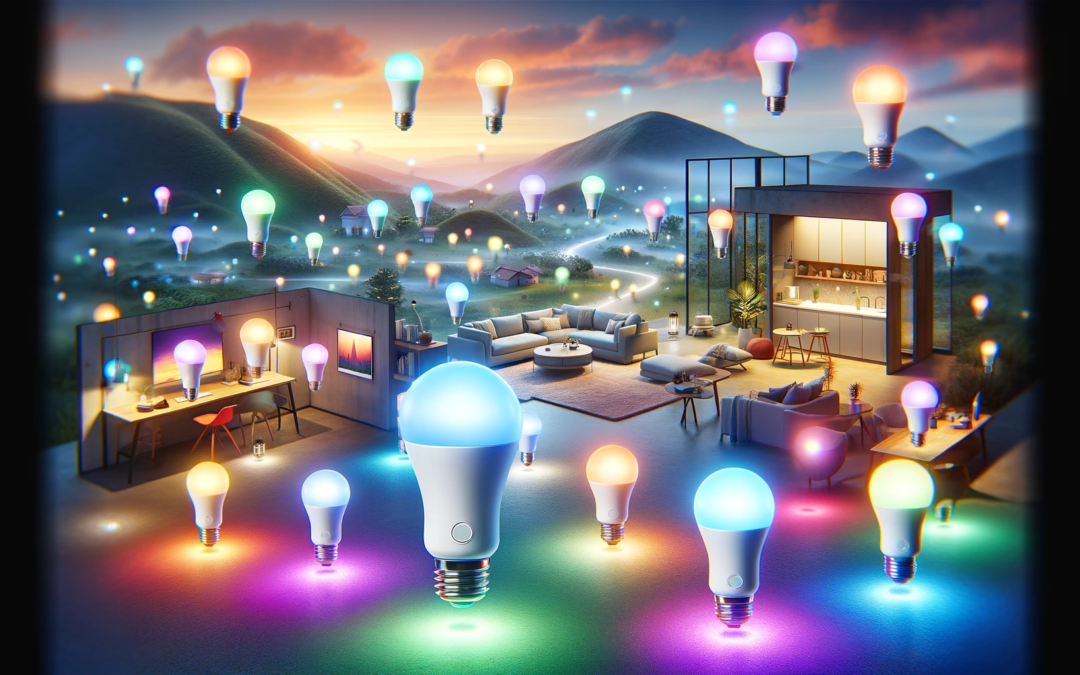In today’s tech-savvy world, smart light bulbs are revolutionizing the way we illuminate our homes. These ingenious devices offer a blend of convenience, energy efficiency, and customization that traditional light bulbs simply can’t match. Imagine controlling the ambiance of your room with just a tap on your smartphone or a voice command, scheduling your lights to turn on or off while you’re away, or even syncing them with your favorite music. Smart light bulbs provide all these features and more, making them an essential component of any modern smart home setup.
From enhancing home security to setting the perfect mood for a movie night, smart light bulbs come in a variety of shapes, sizes, and capabilities to suit every need. In this comprehensive guide, we delve into the top 10 smart light bulbs available in the market, examining their features, pros, cons, and what makes each of them stand out. Whether you’re a tech enthusiast or just looking to upgrade your home lighting, this list will help you find the perfect smart bulb for your space.
1. Philips Hue White and Color Ambiance (Amazon)
- Key Features: Voice control, 16 million colors, compatible with Alexa, Google Assistant, and Apple HomeKit, Energy Star certified
- Pros: Wide color range, high compatibility with smart home systems, energy-efficient, easy to set up
- Cons: Higher price point, requires a Hue Bridge for full functionality
- Description: Philips Hue is a pioneer in the smart lighting arena, and their White and Color Ambiance bulb is a testament to their innovation. This bulb offers an impressive range of 16 million colors, allowing you to transform your space to fit any mood or occasion. It integrates seamlessly with major smart home systems like Alexa, Google Assistant, and Apple HomeKit, providing effortless voice control. Despite its higher price, the energy efficiency and versatility of this bulb make it a top choice for those looking to add both color and convenience to their home.
2. LIFX A19 LED Light (Amazon)
- Key Features: Wi-Fi enabled, no hub required, 16 million colors, dimmable, works with Alexa, Google Assistant, and Apple HomeKit
- Pros: Easy installation, bright and vibrant colors, robust app features, energy-efficient
- Cons: Slightly higher price, occasional connectivity issues
- Description: The LIFX A19 stands out for its hub-less design, making it a breeze to set up. This Wi-Fi-enabled bulb shines bright with its vivid colors and impressive dimming capabilities. It works well with various smart home assistants, offering a high degree of control and customization. While it’s priced on the higher side, the LIFX A19 compensates with its rich feature set and energy-saving benefits, making it a great choice for those who want hassle-free smart lighting.
3. TP-Link Kasa Smart Light Bulb (Amazon)
- Key Features: No hub required, dimmable, energy monitoring, compatible with Alexa and Google Assistant, scheduled usage
- Pros: Easy setup, affordable, energy usage tracking, reliable connectivity
- Cons: Limited color options, requires a stable Wi-Fi connection
- Description: The TP-Link Kasa is an excellent option for those seeking a simple yet effective smart light bulb. Its no-hub-required setup means you can start using it right out of the box. The bulb offers useful features like energy monitoring and the ability to schedule usage, which can help save on electricity bills. Its compatibility with Alexa and Google Assistant adds to its convenience. Although it lacks the wide color range of some competitors, its affordability and functionality make it a strong contender in the smart lighting market.
4. Sengled Smart LED Multicolor (Amazon)
- Key Features: Compatible with Alexa and Google Assistant, 16 million colors, hub required, energy-efficient, scheduled usage
- Pros: Vibrant color options, affordable, easy integration with smart home systems
- Cons: Requires a separate hub, limited third-party integrations
- Description: Sengled’s Smart LED Multicolor bulb is a budget-friendly option that doesn’t skimp on features. It offers a rich palette of 16 million colors, adding a splash of vibrancy to any room. While it requires a separate hub to unlock its full potential, this bulb is perfect for users who already have a compatible smart home system. Its compatibility with Alexa and Google Assistant allows for easy voice control, and its scheduled usage feature can help in managing energy consumption. Despite its limited third-party integrations, the Sengled Smart LED Multicolor is a great choice for those who want colorful lighting options without breaking the bank.
5. Wyze Bulb Color (Amazon)
- Key Features: Wi-Fi enabled, no hub required, 16 million colors, works with Alexa and Google Assistant, dimmable
- Pros: Affordable, bright and vibrant colors, intuitive app control, good connectivity
- Cons: No Apple HomeKit support, limited features compared to premium models
- Description: The Wyze Bulb Color is a standout for its excellent value for money. Offering a spectrum of 16 million colors and easy Wi-Fi connectivity without the need for a hub, it’s a hassle-free choice for smart lighting beginners. While it lacks compatibility with Apple HomeKit and some of the advanced features of higher-end models, its affordability, ease of use, and robust performance make it an attractive option for those on a budget.
6. Nanoleaf Essentials Bulb (Amazon)
- Key Features: Bluetooth and Thread enabled, 16 million colors, works with Apple HomeKit, Google Assistant, and Alexa, customizable scenes
- Pros: Unique design, rich color capabilities, Thread technology for improved connectivity, energy-efficient
- Cons: Higher price point, requires a compatible border router for Thread
- Description: Nanoleaf Essentials stands out with its distinctive design and advanced connectivity options. Its support for both Bluetooth and Thread technology ensures a stable and responsive lighting experience. The bulb’s compatibility with major smart home platforms and its ability to create customizable scenes offer a high degree of personalization. Although it’s priced higher than some alternatives and requires additional hardware for optimal Thread performance, its unique features and reliability make it a compelling choice for tech enthusiasts.
7. GE Lighting Cync Smart Bulb (Amazon)
- Key Features: Wi-Fi and Bluetooth enabled, no hub required, works with Alexa and Google Assistant, dimmable, adjustable white light
- Pros: Easy to set up, reliable performance, versatile white light adjustments, affordable
- Cons: No color options, requires Cync app for setup
- Description: GE Lighting’s Cync Smart Bulb is an excellent choice for those who prefer simplicity and reliability. It offers both Wi-Fi and Bluetooth connectivity, ensuring easy setup and stable operation. The bulb’s ability to adjust white light tones from warm to cool makes it versatile for different settings. While it lacks color options, its affordability and solid performance make it a great option for everyday smart lighting needs.
8. Eufy Lumos Smart Bulb (Amazon)
- Key Features: Wi-Fi enabled, no hub required, works with Alexa and Google Assistant, dimmable, energy-efficient
- Pros: Affordable, straightforward setup, reliable performance, energy-saving
- Cons: No color options, limited features
- Description: The Eufy Lumos Smart Bulb is a no-frills choice that delivers consistent and efficient performance. Its easy setup and compatibility with major smart assistants make it accessible for all users. While it doesn’t offer color options and has limited advanced features, its affordability and energy efficiency make it an excellent choice for those seeking a basic, reliable smart bulb.
9. Ring A19 Smart LED Bulb (Amazon)
10. Govee Smart LED Bulb (Amazon)
- Key Features: Bluetooth and Wi-Fi connectivity, 16 million colors, works with Alexa and Google Assistant, dimmable, music sync
- Pros: Vibrant color options, easy app control, music synchronization feature, affordable
- Cons: No Apple HomeKit support, Bluetooth range limitations
- Description: The Govee Smart LED Bulb is a colorful and fun addition to any smart home setup. It stands out with its 16 million color options and unique music sync feature, allowing the light to change with the beat of your music. Its dual connectivity options offer flexibility in usage. Despite lacking Apple HomeKit support and having some limitations with Bluetooth range, its affordability, and vibrant feature set make it a great option for those looking to add a splash of color and rhythm to their lighting.
FAQ’s
1. What are the defining characteristics of smart light bulbs?
Smart light bulbs stand out from traditional light bulbs due to their advanced features and connectivity. These bulbs can typically connect to home Wi-Fi or Bluetooth, allowing users to control them remotely via smartphones or smart home devices. They often offer adjustable brightness and color temperature, and some can even change colors. Voice control through virtual assistants like Amazon Alexa, Google Assistant, or Apple HomeKit is another key feature. Additionally, smart bulbs can be programmed with schedules and timers for automated lighting, and they often boast energy-saving LED technology.
2. How do smart light bulbs contribute to energy efficiency and cost savings in a household?
Smart light bulbs are usually LED, which inherently use less energy than traditional incandescent or halogen bulbs. This translates to lower electricity bills. Their smart features further enhance energy savings: users can schedule bulbs to turn off when not needed, or control them remotely to avoid leaving lights on unnecessarily. Some smart bulbs even offer features like ambient light adjustments based on the time of day or occupancy sensors, ensuring they’re only on when needed. Over time, these efficiencies can lead to significant cost savings.
3. What are the integration capabilities of smart light bulbs with other smart home devices?
Smart light bulbs are often designed to seamlessly integrate with a wider smart home ecosystem. They can work in conjunction with smart speakers, home assistants, smart thermostats, and security systems. This integration allows for coordinated actions, like lights turning on or changing color in response to other triggers – for example, a security alarm going off or the thermostat signaling that someone has entered the house. Compatibility with platforms like IFTTT (If This Then That) also enables users to create custom automation and routines for a fully interconnected smart home experience.
4. What should consumers consider when choosing smart light bulbs for their homes?
When selecting smart light bulbs, consumers should consider compatibility with their existing smart home systems and virtual assistants. Bulb fitting and size are also important to ensure they fit existing fixtures. Additionally, considering the range of color and brightness options is crucial, especially for those looking to create specific moods or scenes. The ease of setup and use, especially in terms of the associated app, is another important factor. Lastly, consumers should factor in the cost, both initial and long-term, as some smart bulbs can be more expensive upfront but offer savings over time due to their energy efficiency.
5. Are there any security and privacy concerns associated with using smart light bulbs?
While smart light bulbs offer convenience and efficiency, they also raise certain security and privacy concerns. Since they connect to home networks, there’s a risk of unauthorized access if the network is not secure. Hackers could potentially control the bulbs or access personal data. To mitigate these risks, users should ensure their home network is secure, use strong passwords, and regularly update bulb firmware. It’s also advisable to check the privacy policies of the bulb manufacturers to understand what data is collected and how it’s used.











